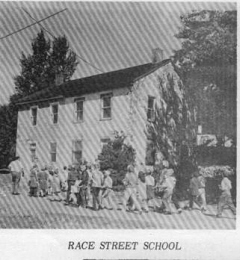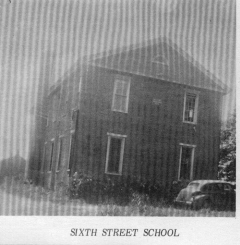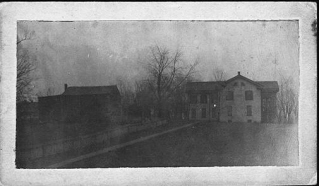School District
 Prior to the year 1849 the children residing at Upland were compelled to attend school at Sneath's Corner (now Brookhaven), or at the "Old Mud Wasp" school at Cartertown. (it was located somewhere on the grounds of the old Yanks Poultry Farm in Feltonville, Chester Township). The distance from Upland to these schools was a serious difficulty to the residents of the village, for in the winter season and early spring the roads would often be almost impassable for weeks at a time, the clay soil having softened to a thick adhesive mud. Female children frequently could not go to school for days.
Prior to the year 1849 the children residing at Upland were compelled to attend school at Sneath's Corner (now Brookhaven), or at the "Old Mud Wasp" school at Cartertown. (it was located somewhere on the grounds of the old Yanks Poultry Farm in Feltonville, Chester Township). The distance from Upland to these schools was a serious difficulty to the residents of the village, for in the winter season and early spring the roads would often be almost impassable for weeks at a time, the clay soil having softened to a thick adhesive mud. Female children frequently could not go to school for days.
John P. Crozer, in the year 1849, proposed to the school directors of Chester Township that if they would establish a school at Upland he, at his personal expense, would erect a building which could be used exclusively for school purposes without cost to the board. This offer was accepted, a schoolhouse was built on Race Street, not far from the Pusey house, a school (today we call it the Crozer Schoolhouse) was established, and Mrs. Warren Dixon was employed to teach the pupils. Unfortunately she left no records behind. By 1853 the teacher was a Mr. A. Williams who noted in his school "diary" that the term had been 240 days in length and that Independence Day was celebrated as a school holiday.
In 1855, the same Mr. Williams carefully recorded an unusually large enrollment of 45 males and 42 females. Yet since compulsory attendance had not yet been enacted, an average of only 30 pupils attended daily, and the average student was present for a mere one-quarter of the long school term. It is enlightening to note that this early schoolmaster attempted to adapt his requirements to the pupils' individual needs and abilities as he wrote in his meticulous hand the following:
Number of students taking reading 85
Number of students taking spelling and definitions 32
Number of students taking writing 63
Number of students taking geography 30
Number of students taking arithmetic 46
Number of students taking grammar 9
Sometime in the course of its short school life, an evening class for the benefit of working children was established in this building. Although exact records of the operation are missing, it is known that the night school was conducted with 22 students on roll throughout 1856.


For nine years this building was used by the directors, but in 1858 the number of children applying for admission to the public school compelled the erection of a new building. A lot was purchased at the corner of 6th Street and Upland Avenue, and the brick schoolhouse known as No. 1 was built to accommodate two schools (classrooms). In 1880 it was enlarged, and in 1884 it had accommodations for four schools (classrooms). Upland had increased so much in population that in 1868 the Hill schoolhouse, a stone building known as No. 2, (later known as Hill Street School) was erected, and two schools established therein. In the six schools in 1884 about three hundred and twenty-five pupils were in attendance.
When the borough of Upland was incorporated, in 1869, it was made an independent school district. For the first time our schools were completely under our control and administration. But the inadequacy of these two school buildings to house the burgeoning school population soon became apparent. James W. Baker, then county school superintendent, wrote in the annual "Pennsylvania School Report" of 1876 that "Upland needs and has needed more school room for the last four or five years. Both schools are badly over-crowded. Although there is almost enough money in the treasury to provide needed space, they, (i.e. the local school board) have made no attempt to do so." The over-crowded conditions were somewhat relieved in 1880 when School #1 was sufficiently enlarged to accommodate four classes. Further relief was afforded by the addition of two more rooms to School #2 in 1884.
Existing records indicate that a night school was conducted in School #2 at least from January of 1883 through 1888. In the opening year J. W. Parsons, district principal, instructed one class; Miss Mira Goodhart, a second class. Subsequent teachers were Miss Lida Sullivan, 1884-1885; Miss Harriet Castle, 1886-1887; and Miss Irene Compton, 1887-1888. Here the records end, but some interesting data remain. Usually more males than females were on the roll; these included adults as well as children. The enrollment fluctuated wildly, numbering as many as 58 one month and a mere 23 the next. Attendance was poor and dropped sharply during the winter seasons. The one truly consistent feature seems to have been the course of study which presented the traditional three R's plus spelling.
With the establishment of a high school in School #2, Upland took a giant educational step forward in 1884. Miss Lida Sullivan, then district principal, served as instructor until the close of the 1888 term. These school terms were long, often opening late in August and extending into the following July. Holidays were infrequent and short; the Christmas break seldom lasted more than two or three days. Enrollments were small and rarely averaged more than 20 to 25 students.
Since no grade levels were indicated before 1889, pupils presumably "went" to high school, not to a specific grade. The curriculum seemed extremely ambitious to say the least. Listed as compulsory subjects were reading, spelling, penmanship, United States history, geography, physiology, written arithmetic, algebra, grammar, and composition. In addition, most students were enrolled in the literature class and, after 1885, in the bookkeeping class as well. A small number, ranging from 10% to 40% of the group, also studied geometry and philosophy. As to whether the latter two courses were restricted to the advanced, the brilliant, or the interested students only, no clue remains. Pupils were graduated at the end of any term when they attained a general average of 75% or higher - contingent upon a minimum mark of 70% in both grammar and arithmetic.
In September, 1889, Harry S. Borneman replaced Miss Sullivan as district principal and high school instructor. His most notable contribution probably was the establishment of two grade levels in the high school, since successive teachers followed this practice. Walter L. Phillips succeeded Mr. Borneman in 1891 and introduced physics into the curriculum. In his ledger dated October 12, 1892, was the terse note, "Columbus Day observed. 1,000 people on the school grounds." S. D. Knapp filled the post in 1893, followed by George McCracken, who served from 1894 to 1897. During his tenure, Mr. McCracken added the subject of drawing to the course study. Mr. Fred Parsons next held the dual position for three years and was responsible for the addition of Latin to the program, which by then must have proved equally burdensome to both pupil and teacher. Others elected successively to the post but of whose service no accounts can be found were Harvey Parsons, 1901-1902; Harriet Castle, 1903; Alvin Kriebel, 1904; and Professor A. F. K. Krout, 1905-1907.
The winds of change swept in with the coming of George Pedlow in 1908. This principal drastically altered the curriculum, introducing English history and civics; retaining the study of algebra, composition, geography, written arithmetic, bookkeeping, and Latin; and discarding all other matter. Mr. Pedlow resigned, however, in January of 1910 to accept a position in the Chester system, and Miss Jennie Hammond completed his unfinished term. That June the board of directors voted to close the high school permanently and to send only the upper section to Chester High School in the fall semester. Mr. Chester O'Neal was elected principal and teacher of the lower school group for one year, after which all high schoolers were enrolled in Chester. Incidentally, Mr. O'Neal was the first to recommend exemptions from final examinations in any subject in which a pupil attained a yearly average of 85%. Succeeding him in 1911, R. F. Beatty served as principal and eighth grade teacher until his resignation in 1912. The situation then became highly stabilized with the election of Miss Nellie E. Pretty to the vacant post - a position which she filled with great distinction for some thirty years.
Upland must consider itself fortunate in the diligent, dedicated character of its early elementary school staff. Foremost among these teachers were the Castle sisters, as they were familiarly known. Miss Hanna Castle taught first grade for some four or five decades; Miss Sally, after instructing at various levels from second to seventh, settled in fourth grade in 1915 and remained there to the end of her teaching career; Miss Harriet conducted combined seventh and eighth grade until leaving to marry in 1909. Miss Ella Rodeback, elected to the faculty in 1888, taught fourth and sixth grade groups until her assignment in 1909 to fifth grade, which position she retained until her retirement. Entering the system in 1898, Miss Lillian Ross instructed at all levels from third to seventh until 1912, when she resigned to accept a post in Chester.
Two outstanding teachers were engaged by the board in 1899. The one, Miss Nellie E. Pretty, instructed fourth grade until her aforementioned election as principal and eighth grade instructor in 1912; the other, Miss Janet Dawson (Booth), taught second grade for one year and third grade for four years. She resigned in 1904 to marry but returned in January, 1921, to lend her invaluable services to our district again. Many other capable local women served on the faculty, notably: Miss Mabel White (1901-1914), who taught in second, third, fourth and seventh grades; Miss Priscilla Carroll (1903-1910), second grade; Miss Jennie Hammond (1903-1910), seventh, and eighth grades; Miss Pearl Tompkins (1910-1918), third, sixth, and seventh grades; and Miss Bessie Mahon (1914-1918), fourth and sixth grades.
Because of large enrollments, teachers ruled their classes with a firm hand. Students absent five or more days during a term were reported to the board who, in turn, notified parents of the penalties attached thereto. Moreover, the directors had decreed that any act of misconduct, disobedience, or disrespect was just cause for suspension. Pupils suspended under this regulation were subject to severe penalties, reported to the current visiting board member, and reinstated only with his express permission.
Reports of academic progress were issued monthly until 1917 when the number marking periods were reduced to six per term. For promotion, pupils had to attain a general average of 75% in all subjects. However, the more capable ones could advance to a higher grade at any time during the school year on the recommendation of their teachers. In like manner, those averaging below 50% could at any time be transferred to a lower grade. Not until 1912 were students given an opportunity for summer study in failed subjects with promotion contingent upon their success in September re-examinations.
Teacher welfare was a completely neglected area. It was 1919 before a need for death and sick leaves was recognized and a modest schedule provided at partial salary. These salaries themselves were extremely low until a new state law of July, 1919, imposed drastic increases - as much as $15 per month in some cases.
With a dedication equal to that of the faculty, members of several boards of school directors devoted much time, energy, and effort to assure the smooth functioning of our school system. They met with many situations common today - damaged property, defective equipment, prolonged absenteeism, teacher recruitment, needed classroom space, tax assessment (six mils in 1900) - all were there to be solved a century ago. There were numerous problems which now seem quaint. There was the controversy which raged over vaccination at the turn of the 20th century, resolved in September, 1902, when the directors voted to exclude all pupils who did not obtain a certificate of successful vaccination. There was the need to notify neighbors to keep their chickens out of the school yards (1901) and to ban the turning loose of horses in these same yards (1905). There were the complaints about boys running to the foot of Upland Avenue to fetch water for Hill Street School, silenced by installing city water (1907). And, so indicative of its time, there was the board demand that teachers not release pupils during class hours to carry dinners to their working parents without first obtaining the consent of the board president (1912).
During the World War I period the school buildings were so crowded that the "old gym", located behind the home at 33 Main Street, was pressed into service as additional classroom space. Teachers were elected and resigning throughout the terms, lured by higher-salaried offers. So desperate were the directors to keep a full staff that they voted in 1918 and again in 1919 to award an extra month’s pay at the close of the term for any teacher completing it.
The board members took a deep interest in the academic quality of the education presented to our students. Once a year they met with the faculty to reexamine the course of study and determine its continuing soundness. They also received book agents, viewed demonstrations, and adopted the texts they deemed most excellent. Each month a different director was assigned to visit every classroom. This member returned to the board with a detailed report, not only on the academic progress of the pupils, but also on their deportment, their posture and even their method of holding their pens. The commencement exercises, held in the Baptist Chapel until 1912 or 1913, were a special concern of the board. They undertook all arrangements - from music, to speaker, to printing. The board's intimate association with the students and concern for their thorough training were, in a very telling degree, responsible for the excellent academic reputation enjoyed by our pupils throughout the county.
In 1953 an elementary school was built a 6th and Main Streets at a cost of nearly $500,000. Mabel Jackson graduated from West Chester State Teachers College in 1931. She came right to the Upland School system and taught fourth grade from 1931 to 1944. In 1945 she taught sixth grade and from 1946 to 1967 she taught seventh and eighth grades. She was also assistant principal for several years. She retired in 1967.

